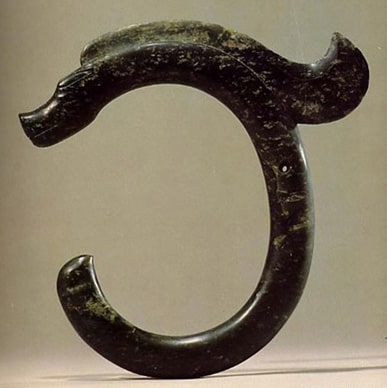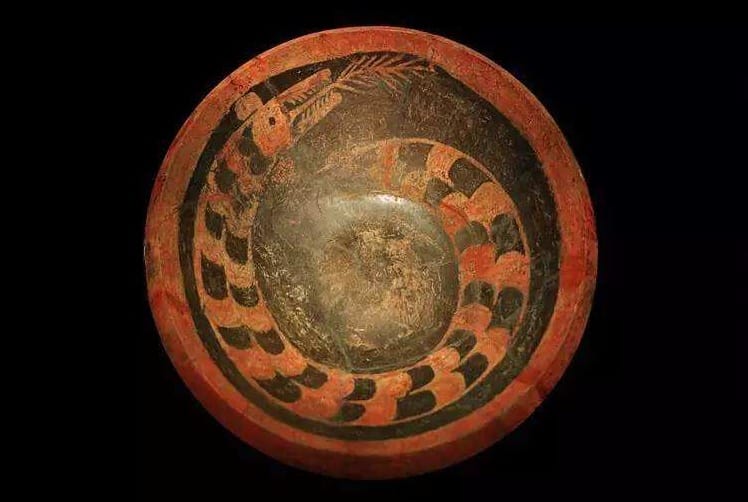Evolution of Dragon Images on Chinese Ceramic and Porcelain

Chinese dragon was not born to current appearance. Dragon images can be found on all kinds of unearthed relics in different historical periods. Ceramic and porcelain are two main subjects to study the evolution of Chinese dragon images and story behind it.
In general, dragon images have developed from simplicity to prosperity, from religion to art, from randomness to standardization and become diversified. As the dragon image has never interrupted through Chinese history, it has become one of the important means to interpret history. Dragon’s hair, eyelashes, feelers and claws varies in different period, which usually can reflect the strength of the country in that period.
Earliest dragon images in Chinese history
Early in the Neolithic Age, dragon patterns were used in jade articles. The representative is the Jade Dragon-boar excavated from Hongshan Culture Relics. And the first dragon image found on pottery is Painted Pottery Plate with Dragon Design excavated at the Taosi Site in Shanxi Province. The site belongs to Longshan Culture (2500-1900BC), noted for its highly polished black pottery. A dragon was painted in snake body with small & round head, scale, rice ear shaped tongue and three-digit claw.

Yet, the jade dragon-boar and dragon-shaped pottery of Hongshan is predated by Yangshao culture, another Neolithic culture in northeastern China from 5000 BC to 3000 BC. In one of the graves, a person was buried between a dragon (on the east side) and tiger (on the west side) of the body made of clam shells. On a pottery basin, two bird-dragon images were painted vividly.

Dragon pattern in early Chinese history were simple and shaped in snake or animals. They might be the totems of clans and tribes.
Dragon images in Xia, Shang and Zhou Dynasties (From 207 BC to 256 BC)
The Erlitou culture in Xia Dynasty, which may have evolved from the matrix of Longshan culture, was an early Bronze Age urban society and archaeological culture that existed in central China from around 1900BC to 1500BC. Many excavated subjects have dragon images and the turquoise dragon is the most famous. Dragon patterns are found on some pottery fragments, which were most in shapes of snake or fish.


In general, dragon patterns in Shang and Zhou Dynasties can be divided into two categories: snake-shaped and beast-shaped. Snake-shaped dragons had a snake body with scale and without limbs and claws. Some patterns were one head with two bodies, while some were one body with two heads. Beast-shaped dragons had a beast body with limbs and claws. Their eyes were usually open and tail was curled. Gradually, beast-shaped dragon became the main category in the following dynasties
Dragon images in Qin Dynasty and Han Dynasty
Qin Dynasty (221 BC — 207 BC) was the first centralized empire in the ancient history of China, which had a unified language, currency, and measurement , after having defeated the other six kingdoms of the Warring States Period (403 BC — 221 BC). The following Han Dynasty, spanning over four centuries, is considered a golden age in Chinese history, and it has influenced the identity of the Chinese civilization ever since. In such a stage of prosperity, dragon almost became the dominator of gods with images look mightier and mysterious. At the same time, many myths and legends about dragon appeared to exalt dragon’s position.

In this period, most dragon images shaped in beast. They had a snake body, four beast feet with three claws each, long head similar to horse’s and with ears and horns. It was very similar to the dragon images we see now.
Dragon images in Tang Dynasty
Tang dynasty (618–907) was one of the top greatest dynasties of imperial China, politically, economically and culturally. It was in this dynasty that dragons came to adorn the emperor's robe as the symbol of power. Since then, dragon robe became the exclusive dress of emperor.Pottery and ceramics were reaching new heights of sophistication that augured the development of China's porcelain industry. Though porcelain in its modern form appeared in late Han Dynasty, mature ceramic firing process was finished in Tang Dynasty and paved a bright way for following glorious china era.


In Tang Dynasty, dragon images were strong with powerful limbs, open mouth and decorated with fire, cloud and waves, which made them more dynamic. Dragon in this period had long head with antler-shaped horns and hair, snake-shaped body with gridded scale instead of fish scale, four feet with hair at joint and three claws each.
Dragon images in Song and Yuan Dynasty
The Song Dynasty was a prosperous period in the development of Chinese traditional porcelain crafts. The ancient ceramic sites found today are distributed in 170 counties across the country, and 75% among them have ceramic sites of Song Dynasty. All Song ceramic kilns are generally classified into six categories: Ding Kiln, Yaozhou Kiln, Jun Kiln, Ci Kiln, Longquan Celadon Kiln and Jingdezhen Blue-and-White Kiln.
In Song Dynasty, dragon and phoenix patterns were widely used on palace porcelains and not allowed to use on folk porcelains. Dragon images usually can be found on porcelains produced in Ding Kiln, Yaozhou Kiln, Jizhou Kiln and Longquan Kiln.
Dragon patterns in the Song Dynasty are characterized by being vigorous and powerful, seemingly extremely swift. Dragon in Song Dynasty had small head, strong body and big feet. The dragon horns bifurcate earlier and have a large curvature with cloud surrounded. Widely opened mouth exposes teeth and tongue. The dragons have several strands of hair and beard floating to the back of the head. Each foot has three or four claws.

Dragon patterns in Yuan Dynasty look elegant and nimble. Dragons soaring up into the sky, dragon playing with balls and dragon hiding partly in the cloud are common patterns. Dragons in this period have flat and long head, thin neck, and strong feet with long and sharp claws.

Dragon images in Ming Dynasty
The Ming Dynasty ruled China from 1368 to 1644 A.D. It was the last ethnic Han-led dynasty in China. Known for its trade expansion to the outside world that established cultural ties with the West, the Ming Dynasty is also remembered for its drama, literature, and porcelain that have become world renowned. Dragons patterns were widely used on porcelains and images changed in its different periods.

Dragon image in early Ming Dynasty is called Cat-face Dragon, as it had a round face similar to cat face. The dragon’s horns were soft and most had five claws. In the following period ruled by Emperor Yongle and Emperor Xuande, the Ming Dynasty entered its flourishing age. Dragon images were the most ferocious and got the name hegemon dragon. It had an exaggerated head, a strong body, uprising hair and five talon-shaped claws. Since this period, five-claw dragon images could be used exclusively by official ceramic kilns.
Dragon images in Qing Dynasty
The Qing Dynasty (1636 – 1912) is the last orthodox dynasty in Chinese history. It was the largest imperial dynasty in the history of China and in 1790 the fourth-largest empire in world history in terms of territorial size. It was the world's most populous country at the beginning of 1900s. Though the Qing was a Manchu-led imperial dynasty, the rulers praised highly of Han cultures, including dragon culture. The convention of the dragon patterns had been followed in general.
In early Qing Dynasty, the dragon looked wild again compare to those in previous dynasty. Dragon’s hairs were erect and claws were sharp.
Under the ruling of Emperor Kangxi, the Qing Dynasty entered its boom period. The dragons looked stronger and more aggressive with a curling body ready to attack at any time. The lower jaw is significantly longer than the upper jaw.

The Qianlong emperor’s long 60-year reign (1736-1795) was a particularly fascinating time in China’s history. During his reign, China was the wealthiest and most populous nation in the world. Calmness and modesty had replaced the wildness in this period. The dragons had long head, smooth and curling tail, dense and neat scales.
The dragon in late Qing Dynasty lost the prestige it should have. Though the images were generally similar to those in Qianlong period, but were drawn more casually.
